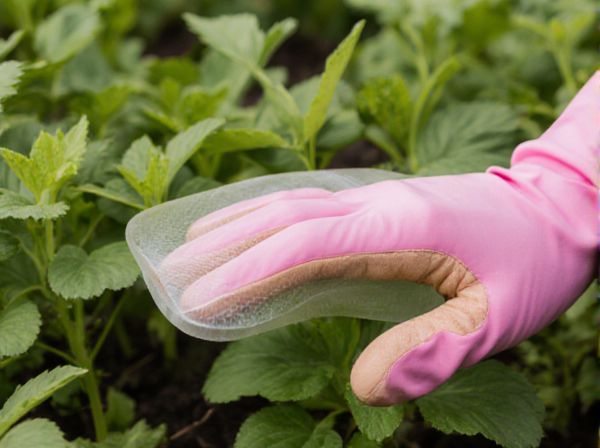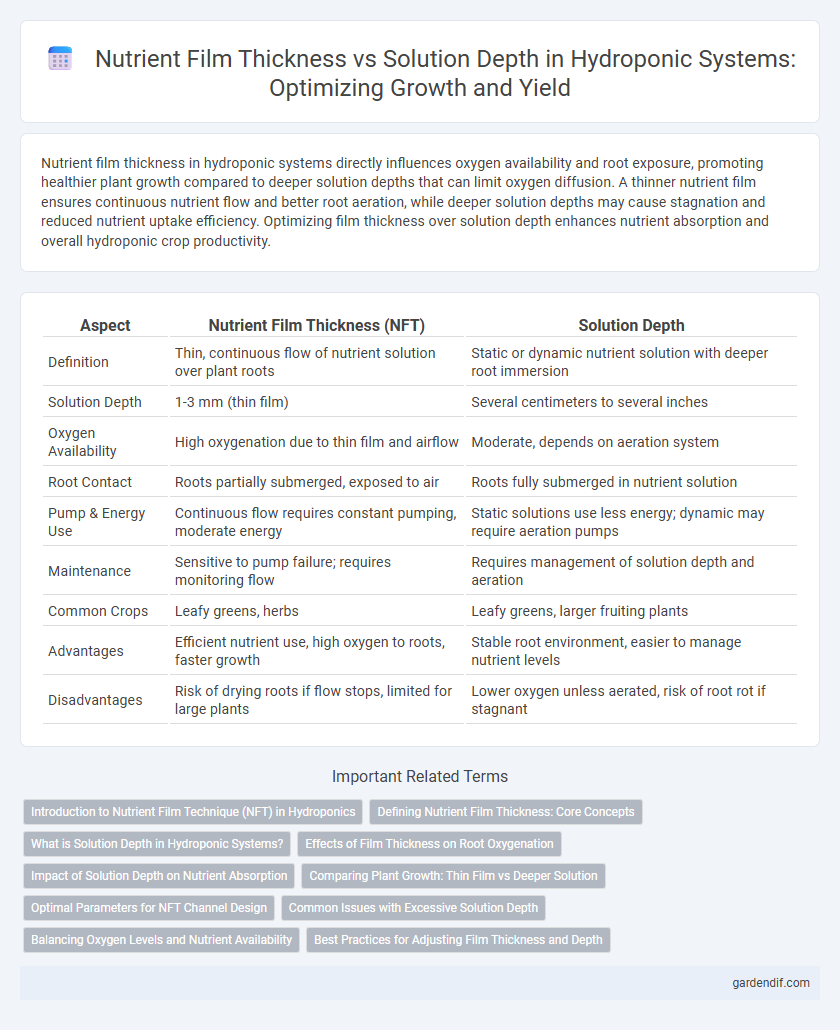
Nutrient Film Thickness vs Solution Depth Illustration
Nutrient film thickness in hydroponic systems directly influences oxygen availability and root exposure, promoting healthier plant growth compared to deeper solution depths that can limit oxygen diffusion. A thinner nutrient film ensures continuous nutrient flow and better root aeration, while deeper solution depths may cause stagnation and reduced nutrient uptake efficiency. Optimizing film thickness over solution depth enhances nutrient absorption and overall hydroponic crop productivity.
Table of Comparison
| Aspect | Nutrient Film Thickness (NFT) | Solution Depth |
|---|---|---|
| Definition | Thin, continuous flow of nutrient solution over plant roots | Static or dynamic nutrient solution with deeper root immersion |
| Solution Depth | 1-3 mm (thin film) | Several centimeters to several inches |
| Oxygen Availability | High oxygenation due to thin film and airflow | Moderate, depends on aeration system |
| Root Contact | Roots partially submerged, exposed to air | Roots fully submerged in nutrient solution |
| Pump & Energy Use | Continuous flow requires constant pumping, moderate energy | Static solutions use less energy; dynamic may require aeration pumps |
| Maintenance | Sensitive to pump failure; requires monitoring flow | Requires management of solution depth and aeration |
| Common Crops | Leafy greens, herbs | Leafy greens, larger fruiting plants |
| Advantages | Efficient nutrient use, high oxygen to roots, faster growth | Stable root environment, easier to manage nutrient levels |
| Disadvantages | Risk of drying roots if flow stops, limited for large plants | Lower oxygen unless aerated, risk of root rot if stagnant |
Introduction to Nutrient Film Technique (NFT) in Hydroponics
Nutrient Film Technique (NFT) in hydroponics relies on a thin, continuous flow of nutrient-rich solution, typically ranging from 1 to 3 millimeters in film thickness, allowing optimal oxygenation and nutrient uptake by plant roots. Maintaining a shallow solution depth ensures rapid nutrient delivery while preventing root submersion, promoting healthy root respiration and minimizing the risk of anaerobic conditions. Precise control of nutrient film thickness enhances growth rates and crop yields in NFT systems used for lettuce, herbs, and other high-value crops.
Defining Nutrient Film Thickness: Core Concepts
Nutrient film thickness refers to the thin layer of nutrient solution flowing over the roots in hydroponic systems, ensuring optimal oxygen and nutrient absorption. This slim layer, typically measured in millimeters, contrasts with solution depth, which is the overall volume of nutrient solution holding the plant roots. Maintaining an ideal nutrient film thickness is critical for maximizing root exposure to oxygen while minimizing nutrient stagnation in hydroponic setups.
What is Solution Depth in Hydroponic Systems?
Solution depth in hydroponic systems refers to the vertical measurement of the nutrient solution reservoir that directly influences root oxygenation and nutrient uptake efficiency. Maintaining an optimal solution depth ensures that plant roots receive adequate access to water, nutrients, and oxygen, preventing root rot or nutrient deficiency. Proper balance between solution depth and nutrient film thickness enhances overall plant growth and yield in hydroponic cultivation.
Effects of Film Thickness on Root Oxygenation
Optimal nutrient film thickness in hydroponic systems directly influences root oxygenation by controlling the balance between nutrient solution contact and air exposure. Thin nutrient films, typically around 1-3 millimeters, enhance oxygen availability to roots by maximizing surface area for gas exchange while maintaining sufficient nutrient supply. Excessive solution depth reduces oxygen diffusion, risking hypoxic conditions that impair root respiration and plant growth.
Impact of Solution Depth on Nutrient Absorption
Solution depth in hydroponic systems directly influences nutrient absorption by controlling oxygen availability to plant roots, where shallow depths maintain a thinner nutrient film that enhances oxygen diffusion and nutrient uptake efficiency. Deeper solution layers may reduce oxygen levels around roots, leading to slower nutrient absorption and potentially stressing plants. Optimizing solution depth to balance sufficient nutrient film thickness with aeration ensures peak nutrient absorption rates and robust plant growth.
Comparing Plant Growth: Thin Film vs Deeper Solution
Thin nutrient films provide consistent oxygen exposure to roots, enhancing nutrient uptake and promoting faster plant growth compared to deeper solution depths. Deeper solutions may limit oxygen availability and increase the risk of stagnant zones, potentially reducing root respiration efficiency. Optimizing nutrient film thickness to maintain a thin, oxygen-rich layer supports robust root development and maximizes hydroponic yield.
Optimal Parameters for NFT Channel Design
Maintaining an optimal nutrient film thickness of 1-3 millimeters ensures efficient oxygen exchange and nutrient uptake in NFT hydroponic channels. Solution depth should balance thin flow to avoid stagnation with sufficient volume to support plant roots, typically ranging between 2-4 centimeters for optimal growth. Proper channel inclination of 1-3% facilitates steady nutrient flow, preventing root desiccation and maximizing yield.
Common Issues with Excessive Solution Depth
Excessive solution depth in hydroponic systems often leads to reduced oxygen availability at the root zone, causing root hypoxia and inhibiting plant growth. Thick nutrient films can result in poor nutrient uptake efficiency due to stagnant water layers and reduced mass transfer rates. Maintaining an optimal nutrient film thickness around 1-3 mm ensures adequate oxygen diffusion and nutrient absorption for healthy root development.
Balancing Oxygen Levels and Nutrient Availability
Maintaining an optimal nutrient film thickness is crucial to balance oxygen levels and nutrient availability in hydroponic systems; a thin nutrient film ensures roots receive adequate oxygen by allowing constant air exposure, while sufficient solution depth guarantees steady nutrient supply. Excessive solution depth can lead to oxygen depletion at the root zone, causing hypoxia and reduced plant growth. Careful regulation of nutrient film thickness and solution depth enhances root respiration and nutrient uptake efficiency, thereby maximizing crop yield and health.
Best Practices for Adjusting Film Thickness and Depth
Maintaining an optimal nutrient film thickness of 1-3 mm ensures adequate oxygenation and nutrient uptake while preventing root suffocation in hydroponic systems. Solution depth should be adjusted between 2-4 cm to balance nutrient availability and root exposure to oxygen. Regular monitoring and slight modifications based on plant species and growth stage optimize root health and overall system efficiency.
Nutrient Film Thickness vs Solution Depth Infographic

 gardendif.com
gardendif.com